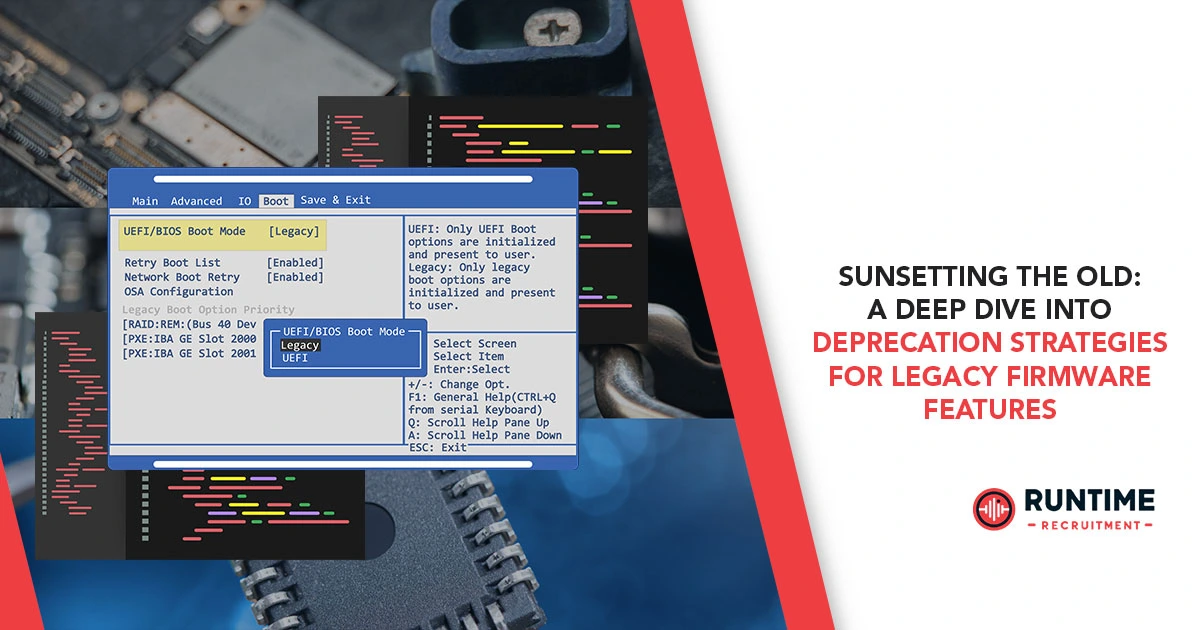Embedded systems are the unsung heroes of our modern world, silently powering everything from medical devices and industrial machinery to smart home gadgets and automotive electronics. Unlike their software counterparts, firmware, the low-level code that breathes life into these devices, often has an exceptionally long lifespan. This longevity, while a testament to robust engineering, inevitably leads to the accumulation of “legacy features” – functionalities that, over time, become obsolete, insecure, inefficient, or simply irrelevant.
Dealing with these legacy firmware features isn’t just a matter of tidying up code; it’s a critical balancing act involving device stability, security, cost, and the user experience. Simply ripping out old code can lead to unforeseen regressions, bricked devices, or disgruntled customers. This article will explore comprehensive deprecation strategies for legacy firmware features, offering practical advice and considerations for navigating this complex landscape.
The Unseen Burden: Why Deprecate Legacy Firmware?
The phrase “if it ain’t broke, don’t fix it” often resonates deeply in the embedded world. A piece of firmware that has been running reliably for years, even decades, can feel untouchable. However, clinging to outdated features carries significant hidden costs and risks:
- Security Vulnerabilities: Legacy features often leverage older cryptographic algorithms, insecure communication protocols, or less robust access control mechanisms. These can become major attack vectors as threat landscapes evolve, exposing devices and sensitive data to compromise. The infamous Mirai botnet, for instance, exploited default credentials in IoT firmware, highlighting the dangers of neglecting security in long-lived devices [Further Reading 1].
- Maintenance Headaches and Technical Debt: Maintaining old, poorly documented, or spaghetti code for features no longer actively used drains engineering resources. Debugging issues within intertwined legacy codebases can be time-consuming and error-prone, slowing down new feature development and increasing overall costs.
- Resource Inefficiency: Older features might consume excessive memory, processing power, or power, leading to reduced performance, shorter battery life, or the inability to implement new, more efficient functionalities. In resource-constrained embedded systems, every byte and every clock cycle counts.
- Limited Scalability and Modernization: Legacy architectures and features can act as roadblocks, preventing the adoption of newer hardware, operating systems, or development paradigms. This stifles innovation and makes it difficult to integrate with modern ecosystems like cloud services or advanced analytics platforms.
- Compliance and Regulatory Issues: As industries mature, new regulations around data privacy, security, and safety emerge. Legacy features that were compliant years ago might no longer meet current standards, leading to legal liabilities or product recalls.
- Poor User Experience: Features that are clunky, confusing, or no longer serve a meaningful purpose can detract from the overall user experience, making the device feel outdated and cumbersome.
The need for deprecation is clear. The challenge lies in doing it strategically and gracefully.
Crafting a Deprecation Strategy: A Multi-Phased Approach
Effective firmware deprecation isn’t a single event but a carefully orchestrated process. It requires foresight, communication, and a robust execution plan. Here’s a multi-phased approach:
Phase 1: Identification and Assessment
The first step is to thoroughly understand what needs to be deprecated and why.
- Inventory and Categorization:
- Feature Audit: Create a comprehensive list of all firmware features, regardless of their perceived current relevance.
- Usage Analysis: Instrument devices (if possible) to collect telemetry on feature usage. Are certain features rarely or never accessed?
- Dependency Mapping: Crucially, map out internal and external dependencies of each feature. Which other firmware modules, hardware components, or external APIs rely on this feature? What downstream systems or user workflows depend on it?
- Risk Assessment: Evaluate each feature for security vulnerabilities, compliance risks, and potential impact on system stability if removed or altered.
- Stakeholder Engagement:
- Cross-Functional Collaboration: Involve product management, sales, customer support, and even key customers in the discussion. Product managers can provide insights into user demand; sales can gauge market impact; customer support can highlight pain points.
- Documentation Review: Consult existing documentation, old specifications, and design documents. Often, the original intent and limitations of a feature are buried within these archives.
- Define Deprecation Tiers: Not all features can be removed at once. Categorize features based on their impact and urgency:
- Immediate Deprecation (High Risk/No Usage): Features with severe security flaws or zero discernible usage.
- Phased Deprecation (Low Usage/High Maintenance): Features that are rarely used but require significant maintenance.
- Soft Deprecation (Alternatives Available): Features that still have some usage but where a superior alternative exists or is being introduced.
- No Deprecation (Critical Legacy): Features that, despite their age, are absolutely critical to core functionality and have no viable replacement in the immediate future. These become candidates for refactoring or isolation rather than outright removal.
Phase 2: Communication and Planning
Transparency is key to a smooth deprecation process, especially for customer-facing devices.
- Clear Communication Plan:
- Internal Announcement: Inform all relevant internal teams (development, QA, support, sales) about the deprecation plan.
- Developer Warnings: For embedded engineers consuming internal APIs or using specific firmware modules, introduce deprecation warnings in documentation, header files, or even runtime logs (e.g., DEPRECATED macros). This provides an early signal.
- Customer Notifications: For features that directly impact users, provide clear and timely communication. This might involve:
- Release Notes: Explicitly list deprecated features in firmware update release notes.
- Support Documentation: Update FAQs, user manuals, and online knowledge bases to reflect changes.
- In-App/Device Notifications: If the device has a display or connectivity, consider on-screen messages or app notifications to inform users.
- Migration Guides: Provide clear instructions on how users can transition to alternative features or workflows.
- Version Control and Branching Strategy:
- Feature Branches: Implement deprecation work on dedicated feature branches in your version control system (e.g., Git).
- Backward Compatibility Strategy: Decide on the level of backward compatibility to maintain. Can older firmware versions still coexist? Will newer firmware break compatibility with older configuration files or peripherals? Often, a “grace period” is established where the deprecated feature still functions but is no longer actively developed or supported.
- Rollback Plan: Always have a clear rollback strategy in case of unforeseen issues during or after deprecation.
- Timeline Definition:
- Deprecation Schedule: Establish a clear timeline for each phase: announcement, soft deprecation, hard deprecation (removal), and end-of-life for the old firmware version. This allows all stakeholders to plan accordingly.
- Phased Rollout: Consider a phased rollout of firmware updates that deprecate features, starting with a smaller user base before a wider release.
Phase 3: Execution and Migration
This is where the actual engineering work takes place.
- Code Isolation and Refactoring:
- Modular Design: If the legacy feature is deeply intertwined, the first step might be to refactor the codebase to isolate it. This makes eventual removal much cleaner and reduces the risk of unintended side effects.
- Interface Definition: Define clear interfaces for the old and new functionalities to allow for a graceful transition.
- Conditional Compilation: Use preprocessor directives (#ifdef, #ifndef) or feature flags to conditionally compile the deprecated feature. This allows for removal in future builds without immediately deleting the code.
- Alternative Feature Development/Enhancement:
- Superior Replacements: Ensure that a robust and superior alternative feature is available and thoroughly tested before deprecating the old one.
- Migration Path: Develop tools or processes to assist users in migrating their configurations or data from the old feature to the new one.
- Thorough Testing:
- Regression Testing: Conduct extensive regression testing to ensure that the removal of the deprecated feature does not introduce new bugs or break existing functionalities.
- Integration Testing: Verify that other parts of the system and external integrations still function correctly without the deprecated feature.
- System-Level Testing: Test the entire system under various conditions, including stress tests, power cycling, and edge cases.
- Hardware-in-the-Loop (HIL) Testing: Critical for embedded systems, HIL testing allows for realistic testing against actual hardware without full deployment.
- Field Trials: If applicable, conduct limited field trials with the new firmware to gather real-world feedback.
- Graceful Error Handling:
- Informative Error Messages: If a user attempts to access a deprecated feature, provide clear and helpful error messages that guide them towards the new alternative.
- Fallback Mechanisms: Implement fallback mechanisms where appropriate to prevent device bricking in case of unexpected issues during the deprecation process.
Phase 4: Post-Deprecation Management
The work isn’t over once the feature is “gone.”
- Monitoring and Feedback:
- Telemetry Analysis: Continue monitoring device telemetry to ensure the new features are being adopted and that there are no unexpected issues.
- Customer Support Feedback: Closely monitor customer support channels for reports related to the deprecation or issues with the new features.
- Bug Fixing: Be prepared to quickly address any bugs or regressions that surface after deprecation.
- Documentation Updates:
- Archive Old Documentation: Clearly mark old documentation as obsolete or archived.
- Update All Relevant Docs: Ensure all current documentation, user manuals, API references, and internal design documents reflect the removal of the deprecated feature.
- Code Cleanup and Removal:
- Scheduled Deletion: After a defined grace period and sufficient confidence in the transition, physically remove the deprecated code from the codebase. This is critical for reducing technical debt.
- Legacy Branching: Consider maintaining a “legacy” branch if there’s a strong need to support very old hardware or customers who cannot update. However, this comes with its own maintenance overhead.
Challenges and Best Practices
Deprecating firmware features presents unique challenges in the embedded domain:
- Limited Resources: Unlike general-purpose computing, embedded systems often have severe constraints on memory, processing power, and storage. This makes incorporating “graceful” deprecation mechanisms (like extensive error messages or multiple versions of a feature) more challenging.
- Physical Accessibility: Many embedded devices are deployed in remote, inaccessible, or harsh environments, making physical updates or interventions difficult or impossible. This emphasizes the need for robust Over-the-Air (OTA) update mechanisms.
- Long Product Lifecycles: Products can be in the field for decades, requiring very long-term support strategies for legacy firmware.
- Safety and Criticality: In safety-critical applications (medical, automotive, industrial), any change, including deprecation, must undergo rigorous validation and certification.
Best Practices:
- Embrace Modularity from Day One: Design firmware with modularity in mind. Loosely coupled components are far easier to deprecate or replace.
- Automated Testing is Non-Negotiable: Invest heavily in automated unit, integration, and system-level tests. This is your safety net when making changes to core firmware.
- Robust OTA Update Mechanisms: For devices in the field, a secure and reliable OTA update mechanism is paramount for delivering firmware with deprecated features or their replacements. Include fail-safe and recovery mechanisms [Further Reading 2].
- Clear Deprecation Policies: Establish clear internal policies for deprecation, including timelines, communication requirements, and responsibilities.
- Early Warning Systems: Implement mechanisms to provide early warnings to dependent codebases or external systems about impending deprecations.
- Document Everything: From initial design decisions to deprecation rationale and migration paths, comprehensive documentation is invaluable.
- Consider Emulation and Simulation: Before deploying to physical hardware, use emulation and simulation techniques to test and validate changes in a controlled environment, especially when dealing with complex legacy interactions [Further Reading 3].
Case Studies (Hypothetical Scenarios)
- The Obsolete Communication Protocol: A smart home hub uses a proprietary, unencrypted communication protocol for older sensors. As new, more secure standards (e.g., Matter, Zigbee 3.0) emerge, and security vulnerabilities are discovered in the old protocol, the manufacturer decides to deprecate it.
- Strategy: Soft deprecation with a long grace period. New hubs no longer support the old protocol. Existing hubs receive a firmware update that continues to support the old protocol but prominently warns users (via the mobile app and device display) to upgrade their sensors. A trade-in program or discounted modern sensors are offered. After two years, the old protocol support is completely removed from future firmware updates.
- Key Takeaway: User migration incentives and a clear timeline are crucial when physical hardware replacement is involved.
- The Redundant Debug Feature: A legacy industrial controller includes a verbose debug logging feature that, while useful during development years ago, now consumes significant CPU cycles and flash memory in production, and exposes unnecessary internal state.
- Strategy: Immediate deprecation via conditional compilation. The feature is removed from new production firmware builds. For existing devices, a minor update might disable the feature by default, with an option to re-enable it via a highly-restricted, authenticated maintenance interface (if absolutely necessary for field diagnostics), logging warnings if activated.
- Key Takeaway: Internal-facing features with high overhead and security implications can be deprecated more aggressively.
Conclusion
Deprecating legacy firmware features is an unavoidable, albeit often challenging, aspect of embedded engineering. It’s a continuous process that reflects the evolving needs of devices, users, and the security landscape. By adopting a structured, multi-phased approach that prioritizes thorough assessment, transparent communication, meticulous execution, and robust post-deprecation management, embedded engineers can gracefully sunset outdated functionalities, reduce technical debt, enhance security, and pave the way for future innovation. In a world increasingly reliant on connected, long-lived embedded devices, mastering the art of deprecation is no longer an option, but a strategic imperative.
Further Reading
- Apriorit. “10 Best Practices to Ensure Embedded System Security.” Apriorit Blog. https://www.apriorit.com/dev-blog/690-embedded-systems-attacks
- Number Analytics. “Reviving Legacy Systems in Embedded Systems.” Number Analytics Blog. https://www.numberanalytics.com/blog/reviving-legacy-systems-in-embedded-systems
- Meegle. “Firmware Development Best Practices.” Meegle. https://www.meegle.com/en_us/topics/firmware-development/firmware-development-best-practices









